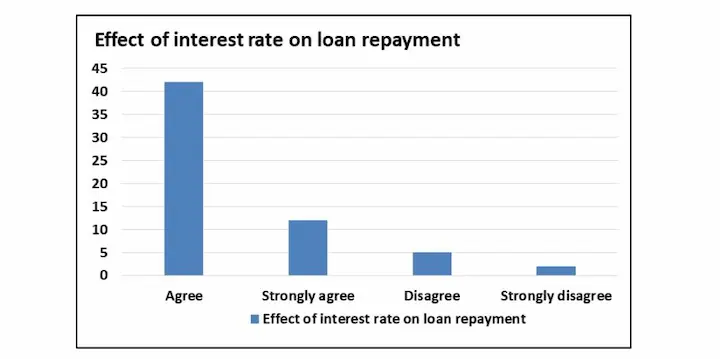The allure of a low-interest personal loan is irresistible for many. The promise of low monthly payments, the ease of access to funds, and the ability to consolidate debt are extremely appealing. But borrowers should understand what they are, how they work, and if they are right for them before applying for a loan. Personal loans offer an option for people who need money fast but do not have the best credit score or collateral available. They provide borrowers with flexibility regarding repayment periods and payment amounts while offering competitive interest rates that help reduce overall borrowing costs. Online personal loans provide access to funds much faster than traditional bank loans, allowing borrowers to pay off their debts over time without worrying about fluctuating market rates or other unpredictable factors.
There is no shortage of options for people looking to take advantage of the benefits of low-interest personal loans. Online lenders, local banks, and other financial institutions offer personal loans. But borrowers need to know the different types of borrowing products and research various offers from multiple lenders to find the perfect fit for their unique needs and budget requirements. The following article talks about what borrowers need to know about low-interest loans.
Summary
- Low-interest personal loans offer several advantages over other forms of credit, including reduced total cost, greater flexibility, easier management, longer repayment terms, and no asset risk.
- The interest rate on a low-interest personal loan is generally lower than other financing options, which helps borrowers save a significant amount of money over time due to reduced total costs.
- Low-interest personal loans have fewer fees than other forms of credit, such as credit cards, making them an attractive option for people looking to save money.
- Understanding the differences between fixed and variable APR is necessary when choosing a low-interest personal loan, as it significantly affects the total cost of the loan and the borrower’s ability to pay it back.
- Borrowers of low-interest personal loans can use the funds for various purposes, such as consolidating high-interest debts, financing a home renovation, or covering unexpected expenses.
- Repayment terms for low-interest personal loans are more flexible than other loans, allowing borrowers to choose a repayment plan that fits their budget and pay off their debt in a manageable way.
Benefits of Low-Interest Personal Loans
Low-interest personal loans are a popular financial tool for many people, providing several advantages over other forms of credit. Its biggest benefit is the potential to save thousands of dollars in total costs over time due to reduced or eliminated fees associated with higher interest rates. Low-interest personal loans offer greater flexibility in budgeting, easier management of monthly payments, longer repayment terms, and no asset risk making them an attractive option for people looking to invest in their future without taking unnecessary financial risks. The benefits of low-interest personal loans include reduced total cost, greater flexibility, easier to manage, longer repayment terms, and no asset risks.
Reduced Total Cost
The interest rate is a key factor when getting a personal loan. A low-interest personal loan has an interest rate lower than the average rate offered by other financing options, such as credit cards or payday loans. Securing a low-interest personal loan helps borrowers save significant money over time due to reduced total costs. A notable advantage of low-interest personal loans is that they have lower fees than other forms of credit. For example, credit card companies charge annual fees, balance transfer fees, late payment fees, and cash advance fees. The fees add up quickly and significantly increase the total cost of borrowing. Low-interest personal loans have fewer fees and are usually lower than those charged by credit card companies.
Another factor that contributes to reduced total costs is the interest rate itself. High-interest rates significantly increase the total cost of borrowing, whereas low-interest rates save borrowers thousands of dollars in interest payments over the life of the loan. Choosing a low-interest personal loan allows borrowers to reduce the overall cost of borrowing and save money in the long run.
Greater Flexibility
Low-interest personal loans offer greater flexibility to individuals who need to manage their finances more effectively. Borrowers can allocate more of their monthly payments towards paying off the principal rather than just accruing added interest each month. Borrowers can pay off their debt more quickly and save on interest payments in the long run. Borrowers of low-interest personal loans can use the funds for various purposes, such as consolidating high-interest debts, financing a home renovation, or covering unexpected expenses. The flexibility helps individuals better manage their finances and achieve their financial goals.
Easier to Manage
Low-interest personal loans are easier for borrowers to manage because they have smaller monthly payments than high-interest loans. The interest rate on low-interest personal loans is lower than on other types of loans. Smaller monthly payments help borrowers to better manage their finances by keeping track of their expenses and avoiding missed payments. It allows borrowers to avoid defaulting on their loans, which leads to late fees, damage to their credit score, and potential legal action. The repayment terms for low-interest personal loans are more flexible than other types of loans, which makes them easier to manage. It helps borrowers choose a repayment plan that fits their budget and allows them to pay off their debt in a manageable way. Depending on their financial situation, Borrowers can choose repayment terms, such as a shorter or longer term.
Longer Repayment Terms
Borrowers agree to pay the loan funds within a certain timeframe, the repayment term. The repayment terms for low-interest personal loans are generally longer than other forms of credit, such as credit cards or payday loans. It means borrowers have more time to repay the borrowed money, which is beneficial when cash flow is limited or unpredictable. A longer repayment term provides stability to borrowers facing financial hardship, such as job loss or unexpected medical expenses. A longer repayment term allows borrowers to make smaller monthly payments over a longer period, making it easier to manage their finances and avoid defaulting.
In our commitment to providing accessible financial solutions, we are proud to extend our low-interest personal loans to residents in several American states. Below is a list of states where our company is actively serving individuals with fair credit, offering them the opportunity to secure affordable personal loans online. We understand that maintaining financial stability is essential, and we’re dedicated to supporting our customers on their financial journeys. Please refer to the table below to find out if we operate in your state and how we can assist you in achieving your financial goals.
| AL / Alabama | AK / Alaska | AZ / Arizona |
| AR / Arkansas | CA / California | CO / Colorado |
| CT / Connecticut | DE / Delaware | DC / District Of Columbia |
| FL / Florida | GA / Georgia | HI / Hawaii |
| ID / Idaho | IL / Illinois | IN / Indiana |
| IA / Iowa | KS / Kansas | KY / Kentucky |
| LA / Louisiana | ME / Maine | MD / Maryland |
| MA / Massachusetts | MI / Michigan | MN / Minnesota |
| MS / Mississippi | MO / Missouri | MT / Montana |
| NE / Nebraska | NV / Nevada | NH / New Hampshire |
| NJ / New Jersey | NM / New Mexico | NY / New York |
| NC / North Carolina | ND / North Dakota | OH / Ohio |
| OK / Oklahoma | OR / Oregon | PA / Pennsylvania |
| RI / Rhode Island | SC / South Carolina | SD / South Dakota |
| TN / Tennessee | TX / Texas | UT / Utah |
| VT / Vermont | VA / Virginia | WA / Washington |
| WV / West Virginia | WI / Wisconsin | WY / Wyoming |
Understanding Interest Rates
Borrowers need clarification on personal loans, especially when understanding interest rates. It’s best to know the different types of APR to make a good decision. Fixed and variable are the two main categories of APR. The amount borrowers pay monthly or yearly on fixed-rate APR stays the same throughout the loan period. The opposite happens with variable APR. The cost changes because of market conditions or government policies. Certain lenders offer low-interest rates during a promotional period, which usually lasts six months up to three years. Choosing the right type of APR is necessary when getting a personal loan. It significantly affects the total cost of the loan and impacts the borrower’s ability to pay it back. Understanding the differences between fixed and variable APR and how they change over time is key to making an informed decision. Borrowers must carefully factor in their financial situation and loan needs before selecting an APR type and ensure they have thoroughly reviewed all the terms and conditions of the loan agreement.
Fixed Vs. Variable APRs
Exploring fixed and variable annual percentage rates (APRs) are necessary to get a personal loan. Comparing the two options gives borrowers insight into which interest rate fits their needs. Understanding how each APR works helps borrowers determine which option gives them the most advantage. Fixed APRs offer predictability regarding the repayment amounts. They remain at the same level throughout the loan. It means that the payments are not affected regardless of changes in market trends or other economic factors. Listed below are the benefits of selecting a fixed APR.
- Guaranteed stability for budgeting purposes.
- Knowing exactly how much must be paid each month.
- Easier ability to pay off debt on time.
- The lower risk is associated with fluctuating markets.
The variable APRs are more dynamic than fixed APRs as they move up and down based on fluctuations in market conditions like prime rates. Borrowers have lower monthly payments if interest rates fall, making it easier to pay off their debts. But borrowers face increased risks if rates rise unexpectedly. Listed below are the things borrowers must know when choosing variable APR.
- Increased chance of higher costs.
- Potential difficulty making regular payments.
- The risk is taken when betting against inflationary pressures.
- Uncertainty regarding future payment amounts.
Borrowers must carefully weigh their circumstances, repayment objectives, and long-term financial planning strategies when choosing between fixed and variable APRs. It’s necessary to select the right fit for their needs. The chosen option must provide comfort in knowing that repayments are manageable and that financial obligations are met successfully without problems.
How to Apply for A Personal Loan
Low-interest personal loans are a popular financing option for many Americans. About 20 million Americans apply for personal loans every year, according to LendingTree. The advantage of low-interest personal loans is that they offer a more affordable way to borrow money than credit cards, which have higher interest rates. People can use personal loans for various purposes, such as consolidating debt, financing home improvements, or covering unexpected expenses. Applying for a personal loan is easy, especially if it’s from an online lender. Listed below are the steps on how to apply for a personal loan.
- Determine the credit score. Before borrowing a personal loan, the first step is to know the credit score. The credit score is a numerical representation of the borrower’s creditworthiness. Checking the credit score allows borrowers to see if they can get low-interest personal loans. A good credit score increases the chances of loan approval and getting a lower interest rate. Borrowers are free to obtain their credit reports for free from various online credit bureaus.
- Research lenders. Borrowers must look for personal loan lenders and compare their interest rates, terms, fees, and customer reviews. They can research online or ask friends and family members for recommendations.
- Determine how much to borrow. Borrowers must know how much money they need to borrow and how long to repay the loan. Doing so helps them choose the right loan amount and term for their budget and repayment ability.
- Gather the necessary documents. Most personal loan application processes require borrowers to provide proof of income, employment, and identification. Before applying, gather all necessary documents, such as pay stubs, bank statements, and government-issued IDs. Doing so helps streamline the entire application process to get the loan funds quickly.
- Apply for the loan. Borrowers must apply online or in person after choosing the lender and compiling the necessary documents. The application process varies depending on the lender. But applications for online lenders only take a few minutes to complete.
- Review the loan terms. Lenders provide loan offers after approving loan requests. Borrowers must carefully review the loan terms, including the interest rate, repayment period, and any fees associated with the loan. Understanding all the terms and conditions before accepting the loan is best to avoid getting a bad deal.
Credit Score Requirements For A Personal Loan
Lenders look at an individual’s credit score as one of the primary factors when assessing if they can approve a loan application. Understanding what type of credit score is required helps individuals decide if applying for a personal loan is right for them. The exact credit score requirements for securing a personal loan vary from lender to lender and depend on several factors, including the amount being borrowed and the interest rate offered by the lender. But it is generally accepted that most lenders require applicants to have a minimum FICO® Score of 650 to qualify for a personal loan. Certain high-end lenders require higher scores than 650, depending on the terms of their particular offer. It is worth noting that low credit scores do not necessarily disqualify applicants from obtaining a loan entirely. Still, they potentially result in certain restrictions, such as shorter repayment periods or higher interest rates.

Maximum Amounts For A Personal Loan
The maximum amount borrowers can obtain depends on several factors, including the lender, credit score, and income. Personal loan amounts range from a few thousand dollars to $100,000. But most lenders have their maximum loan amounts. For unsecured personal loans, which do not require collateral, the maximum loan amount is lower than for secured loans. The maximum loan amount for unsecured personal loans ranges from $1,000 to $100,000, according to Nerdwallet. Borrowers planning to obtain a larger sum need a secured personal loan, which requires collateral such as a car or a home. It’s best to shop around and compare offers from different lenders to find the best terms and rates for their loans.
| Lender | Credit Score | Income | Loan Type | Maximum Loan Amount | Interest Rate | Loan Term | Total Cost |
|---|---|---|---|---|---|---|---|
| Bank A | Excellent | $60,000 | Unsecured | $50,000 | 7.5% | Five years | $55,269 |
| Bank B | Good | $40,000 | Unsecured | $25,000 | 9.2% | Ten years | $32,104 |
| Bank C | Fair | $25,000 | Secured | $75,000 | 6.8% | Two years | $97,141 |
| Bank D | Poor | $15,000 | Secured | $20,000 | 12.3% | 2 years | $23,045 |
Borrowers with better credit scores and higher incomes can borrow more money at lower interest rates than those with poorer and lower incomes. Unsecured personal loans generally have lower maximum loan amounts than secured ones because the lender is taking on more risk by not requiring collateral. Borrowers should compare offers from different lenders to find the best terms and rates for their loans.
Conclusion
Low-interest personal loans offer several benefits, including reduced total costs, greater flexibility, easier management, and longer repayment terms. Borrowers must research various loan options and understand the different types of APR to make an informed decision that fits their financial situation and budget requirements. Overall, low-interest personal loans are a valuable financial tool for individuals looking to invest in their future without taking unnecessary financial risks.
Frequently Asked Questions
What are the typical interest rates for online personal loans available to individuals with fair credit?
Online personal loan rates for fair credit borrowers typically range from 15-35% APR, depending on the lender’s risk assessment.
How can I improve my chances of getting approved for a low-interest personal loan with fair credit?
Ways to improve approval odds include paying down existing debt, avoiding new credit inquiries, demonstrating stable income, and providing collateral.
Are there any specific requirements or criteria I should meet to qualify for a low-interest personal loan with fair credit?
Typical requirements are a minimum credit score around 640, steady income of $1,500+ per month, and a debt-to-income ratio under 50%.
What is the difference between a secured and unsecured personal loan for fair credit borrowers, and which one is more affordable?
Secured loans require collateral and have lower rates. Unsecured loans don’t require assets but have higher rates and stricter approval criteria.

